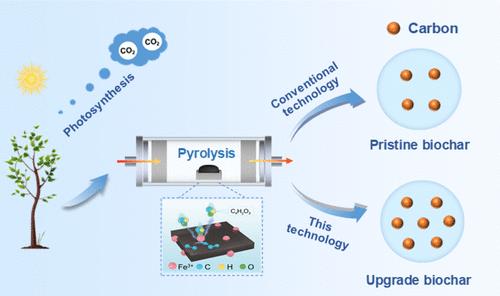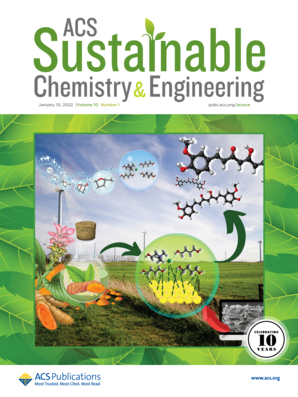Enhanced Carbon Sequestration of Sustainable Biochar via Metal Salt Regulation: Insight into Reaction Mechanism and Carbon Footprint
IF 7.1
1区 化学
Q1 CHEMISTRY, MULTIDISCIPLINARY
引用次数: 0
Abstract
Sustainable biochar can sequester carbon and therefore, mitigate climate change. However, only a small fraction of biomass carbon is retained during biochar synthesis, greatly restricting its carbon-sequestration capacity. A significant boost of the carbon-sequestration potential of biochar has so far been a challenge. This study reveals that when biochar is modified by FeCl3, its carbon-sequestration capacity is boosted to 247.73% of that of pristine biochar derived at 500 °C. Meanwhile, pristine biochar retains only 43.18% of its biomass carbon, while FeCl3-modified biochar retains 75.20% of its carbon by forming complexes between the iron salts and the carboxyl- and hydroxyl-rich organic compounds derived from biomass pyrolysis. As react proceeds, the complexes are further converted into ferrites and organic carbon. The resulting minerals provide physical barriers against carbon decomposition, further enhancing the long-term stability of biochar. Life cycle assessment results further show that ferric salt can markedly enhance the greenhouse gas─reduction potential of biomass-to-biochar-to-soil systems. The more cycles from biomass to upgraded biochar, the more potent the carbon-negative effect is. Undoubtedly, such discoveries hold significant implications for accelerating carbon neutrality.

通过金属盐调节增强可持续生物炭的碳封存:洞察反应机制和碳足迹
可持续生物炭可以固碳,从而减缓气候变化。然而,在生物炭合成过程中,只有一小部分生物质碳被保留下来,这大大限制了生物炭的固碳能力。迄今为止,如何大幅提高生物炭的碳封存潜力一直是个难题。本研究发现,当生物炭经 FeCl3 改性后,其碳螯合能力提高到 500 °C 原始生物炭的 247.73%。同时,原始生物炭仅保留了 43.18% 的生物质碳,而 FeCl3 改性生物炭通过铁盐与生物质热解产生的富含羧基和羟基的有机化合物形成络合物,保留了 75.20% 的碳。随着反应的进行,络合物进一步转化为铁氧体和有机碳。由此产生的矿物质提供了防止碳分解的物理屏障,进一步增强了生物炭的长期稳定性。生命周期评估结果进一步表明,铁盐可显著提高生物质-生物炭-土壤系统的温室气体减排潜力。从生物质到升级生物炭的循环次数越多,碳负效应就越强。毫无疑问,这些发现对加快实现碳中和具有重要意义。
本文章由计算机程序翻译,如有差异,请以英文原文为准。
求助全文
约1分钟内获得全文
求助全文
来源期刊

ACS Sustainable Chemistry & Engineering
CHEMISTRY, MULTIDISCIPLINARY-ENGINEERING, CHEMICAL
CiteScore
13.80
自引率
4.80%
发文量
1470
审稿时长
1.7 months
期刊介绍:
ACS Sustainable Chemistry & Engineering is a prestigious weekly peer-reviewed scientific journal published by the American Chemical Society. Dedicated to advancing the principles of green chemistry and green engineering, it covers a wide array of research topics including green chemistry, green engineering, biomass, alternative energy, and life cycle assessment.
The journal welcomes submissions in various formats, including Letters, Articles, Features, and Perspectives (Reviews), that address the challenges of sustainability in the chemical enterprise and contribute to the advancement of sustainable practices. Join us in shaping the future of sustainable chemistry and engineering.
 求助内容:
求助内容: 应助结果提醒方式:
应助结果提醒方式:


